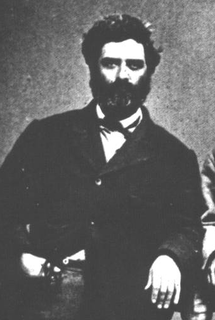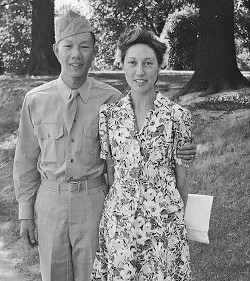Related Research Articles

Collis Potter Huntington was an American industrialist and railway magnate. He was one of the Big Four of western railroading who invested in Theodore Judah's idea to build the Central Pacific Railroad as part of the first U.S. transcontinental railroad. Huntington helped lead and develop other major interstate lines, such as the Southern Pacific Railroad and the Chesapeake & Ohio Railway (C&O), which he was recruited to help complete. The C&O, completed in 1873, fulfilled a long-held dream of Virginians of a rail link from the James River at Richmond to the Ohio River Valley. The new railroad facilities adjacent to the river there resulted in expansion of the former small town of Guyandotte, West Virginia into part of a new city which was named Huntington in his honor.

Olvera Street is a historic street in downtown Los Angeles, and a part of El Pueblo de Los Angeles Historic Monument, the area immediately around the 19th-century Los Angeles Plaza, which has been the main square of the city since the early 1820s, when California was still part of Mexico, and was the center of community life until the town expanded in the 1870s. Many of the Plaza District's historic buildings are on Olvera Street, including its oldest one, the Avila Adobe, built in 1818; the Pelanconi House built in 1857; and the Sepulveda House built in 1887.

Nathaniel Hale Pryor (1772–1831) served as Sergeant in the Lewis and Clark Expedition.

Thomas Oliver Larkin, known in Spanish as Don Tomás Larkin, was an American diplomat and businessman. Larkin served as the only U.S. consul to Alta California during the Mexican era and was covertly involved in U.S. plans to annex California from Mexico. Following the American Conquest of California and the end of the Mexican-American War, Larkin participated at the Monterey Constitutional Convention in 1849 and was a signer of the Constitution of California.

Don Manuel Domínguez (1803–1882) was a Californio ranchero, politician, and a signer of the Californian Constitution in 1849. He served as two terms as Alcalde of Los Angeles (mayor). He was one of the largest landowners in Southern California, having inherited Rancho San Pedro in 1825, one of the largest ranchos in California. He was one of the founders of the cities of Carson and Compton and of the fishing village of San Pedro. Today, California State University, Dominguez Hills and the communities of Rancho Dominguez, East Rancho Dominguez, and West Rancho Dominguez bear his family's name.
Rancho Santa Anita was a 13,319-acre (53.90 km2) land grant in present-day Los Angeles County, California given to naturalized Scottish immigrant Hugo Reid and his Tongva wife. Reid built an adobe residence there in 1839, and the land grant was formally recognized by Governor Pio Pico in 1845. The land grant covered all or portions of the present day cities of Arcadia, Monrovia, Sierra Madre, Pasadena and San Marino. A small portion of the rancho has been preserved as the Los Angeles County Arboretum and Botanic Garden.
Rancho La Ballona was a 13,920-acre (56.3 km2) Mexican land grant in the present-day Westside region of Los Angeles County, southern California.

El Pueblo de Los Ángeles Historical Monument, also known as Los Angeles Plaza Historic District and formerly known as El Pueblo de Los Ángeles State Historic Park, is a historic district taking in the oldest section of Los Angeles, known for many years as El Pueblo de Nuestra Señora la Reina de los Ángeles del Río de Porciúncula. The district, centered on the old plaza, was the city's center under Spanish (1781–1821), Mexican (1821–1847), and United States rule through most of the 19th century. The 44-acre park area was designated a state historic monument in 1953 and listed on the National Register of Historic Places in 1972.
The Battle of Chino, a skirmish of the Mexican–American War occurred on September 26–27, 1846, during which 24 Americans led by Benjamin D. Wilson, who were hiding in the adobe house of Rancho Santa Ana del Chino, were captured by a group of about 50 Californios.

William Rich Hutton was a surveyor and artist who became an architect and civil engineer in Maryland and New York in the latter half of the 19th century. His sketches of the pueblo of Los Angeles and diary of his life as a surveyor in California were published by the Huntington Library.

Tomas Avila Sanchez (1826–1882), soldier, sheriff and public official, was on the Los Angeles County, California, Board of Supervisors and was a member of the Los Angeles Common Council, the legislative branch of the city.
Rancho La Cienega o Paso de la Tijera was a 4,219-acre (17.07 km2) Mexican land grant in present day Los Angeles County, California given in 1843 by Governor Manuel Micheltorena to Vicente Sánchez. "La Cienega" is derived from the Spanish word cienaga, which means swamp or marshland and refers to the natural springs and wetlands in the area between Beverly Hills and Park La Brea and the Baldwin Hills range.
Rancho Paso de Robles was a 25,993-acre (105.19 km2) Mexican land grant in present-day San Luis Obispo County, California given in 1844 by Governor Manuel Micheltorena to José Pedro Narváez. The name means "Pass of the Oaks". The grant encompassed present-day Paso Robles and Templeton.
Rancho Boca de la Playa was a 6,607-acre (26.74 km2) Mexican land grant in present-day Orange County, California given in 1846 by Governor Pío Pico to Emigdio Vejar. The name refers to the wetlands estuary at the 'mouth of the beach,' or 'boca de la playa' in Spanish. This is the most southerly grant in Orange County, and extended along the Pacific coast from San Juan Creek in the south of present-day San Juan Capistrano south to San Clemente.
Flores Daniel Gang, was an outlaw gang also known as "las Manillas", throughout Southern California during 1856-1857. Californio's Juan Flores and Pancho Daniel. Contemporary newspaper accounts of las Manillas all reported that the leader of las Manillas was originally Pancho Daniel, but that Juan Flores assumed the leadership role after Daniel was injured in the Barton ambush. According to the account of Harris Newmark, Flores had been sent to prison for horse-stealing and was just another member of the gang.

Harvey Kilpatrick Stuart O'Melveny, known as H.K.S. O'Melveny, (1823–1893) was a Circuit Court judge in Illinois and a Superior Court judge in California during the 19th century. He was president of the Los Angeles, California, Common Council—the legislative arm of the city—in 1871-72.

John Strother Griffin (1816–1898) was a surgeon attached to the General Stephen W. Kearney expedition from New Mexico to California, a landowner and founder of East Los Angeles and a member of the Common Council of the city of Los Angeles, where he was one of the first university-trained physicians to settle.

James Ohio Pattie was an American frontiersman and author from Kentucky. Between 1824–1830, Pattie took part in a series of fur trapping and trading expeditions, traveling through the American West and Southwest and into modern-day northern and central Mexico.

Gilbert Lester Leong (1911-1996) was a Chinese-American architect who designed churches and public buildings in the Los Angeles area. He was the first Chinese-American to graduate from USC with a degree in architecture. His designs helped shape the architecture of postwar Los Angeles and Chinatown. Leong was also a co-founder of the East West Bank in 1973. The bank was set up to serve the Chinese American community in Southern California.

The Sepúlveda family is a prominent Californio family of Southern California. Members of the family held extensive rancho grants and numerous important positions, including Alcalde of Los Angeles, California State Assemblymen, and Los Angeles County Supervisor.
References
- ↑ "Home - The Huntington Library, Art Collection, and Botanical Gardens". huntington.org. Retrieved 2018-05-07.
- ↑ Pattie, James O. (James Ohio); Flint, Timothy; Bechtel, Nancy; Bechtel, Kenneth K. (Kenneth Karl); Wood, John H. (1831). The personal narrative of James O. Pattie, of Kentucky : during an expedition from St. Louis, through the vast regions between that place and the Pacific Ocean, and thence back through the city of Mexico to Vera Cruz, during journeyings of six years, in which he and his father, who accompanied him, suffered unheard of hardships and dangers ... University of California Libraries. Cincinnati : Printed and published by John H. Wood.
- ↑ "Home - The Huntington Library, Art Collection, and Botanical Gardens". huntington.org. Retrieved 2018-05-07.
- ↑ "18 Jan 1847, Page 2 - The Evening Post at Newspapers.com". Newspapers.com. Retrieved 2018-05-07.
- ↑ Association, American Historical (1907). Annual Report of the American Historical Association. U.S. Government Printing Office.